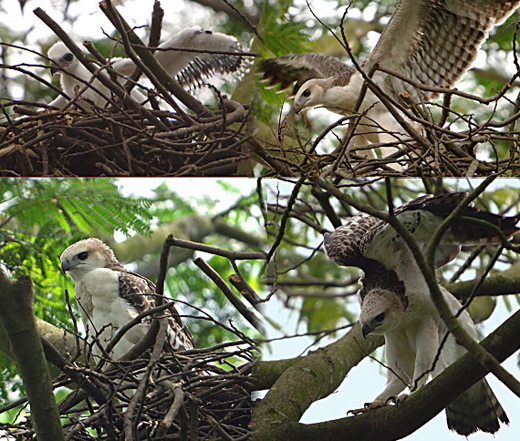Changeable Hawk Eagle (Spizaetus cirrhatus) is a rather uncommon resident in Singapore, with a few pairs remaining.
On 12th May 2006, Mark Chua first sighted the nest of a pair of Changeable Hawk Eagles (pale morph) while out photographing birds in the western part of the island (above). It was made up of large twigs piled high between the fork of a tall tree. Both adults assisted in the building, bringing pieces of the twigs one at a time. It has been reported that the inside of the nest is lined with leaves, that only one egg is laid and only the female does the incubation.
An adult bird was at the nest but soon flew off. The nest appeared empty as initially there was no sign of activities. After monitoring for an hour, he detected movements. There was a white object in the nest – it was a chick (left top). The chick would pop up once in a while to survey the surroundings. Then he saw a wall of feathers. The other adult eagle was also in the nest, being there for a long time, maybe three to four hours, not moving until then.
Hoping that there might be an unhatched egg or more than one chick still in the nest, Mark kept on visiting the area. He returned to the site two days later. One adult visited the nest for a few minutes and left. There was only one very active and lively chick. One week later the chick had grown bigger and stronger. The white down on the wings had given way to some black or brown juvenal feathers (left bottom).
The adult flew in regularly within 90 minutes or so when the chick called. However, as the chick grew older, the adults left it alone for longer periods, sometimes up to three hours.
On 21st May, ten days after he first detected the nest, the grown chick was moving about, not hiding when Mark was observing, unlike when it was younger. The chick was still covered with mostly white down feathers and the flight feathers were in the form of pin feathers (below: top left). Even then, the chick was actively exercising its wings. The adult was then around and brought food for the chick. It would not feed the chick when someone was around, preferring to stay about 50 metres away. It was still waiting when Mark left. Another 28 days (18th June) and the flight feathers were then fully formed, magnificent in their white with light brown bars (below: top right). The chick was still testing its wings, flapping them whenever a strong breeze blew through. A few days later it even managed to lift up a few metres above the nest.
On 2nd July, less than two months after the nest was spotted, the chick moved out from the nest and perched on a nearby branch (above: bottom left). The adult was about 30 metres away, ignoring its call but always watching. The chick was about to make its first flight. Then on 9th July the chick took the plunge and flew to a nearby branch (above: bottom right). It had finally fledged.
Mark Chua
Singapore
July 2007











